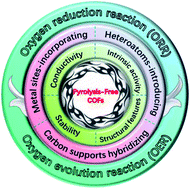Pyrolysis-free covalent organic framework-based materials for efficient oxygen electrocatalysis
Abstract
Low-cost and high-performance electrocatalysts towards oxygen electrocatalysis play a vital role in the widespread application of oxygen-based sustainable-energy technologies such as fuel cells, metal–air batteries and water electrolysis. Even though an enormous number of noble metal-free carbon-based materials have been proved to have comparable electrocatalytic performance to the noble metal-containing benchmarks, the unpredictable and poorly defined active sites resulting from the commonly required pyrolysis greatly hindered the insightful understanding of structure–activity relationships. Pyrolysis-free covalent organic frameworks (COFs) as a unique class of crystalline porous polymers provide an ideal platform for electrocatalysis research due to their tunable porosity, atomically precise structures and programmable topological architectures. Particularly, the elimination of high-temperature pyrolysis enables well-preserved active sites to gain deep insights into the electrocatalytic mechanisms. In this review, we first discuss the pros and cons of pyrolysis-free COFs for oxygen electrocatalysis. Then, recent advances in pyrolysis-free COF-based oxygen electrocatalysts are comprehensively overviewed. The engineering strategies for pyrolysis-free COF-based oxygen electrocatalysts are discussed and paid particular attention, emphasizing their impact on electronic structure modulation and synergistic enhancement effect. Lastly, we also propose the key challenges and future perspectives for maximizing the superiorities of pyrolysis-free COF-based oxygen electrocatalysts. This article aims to emphasize the significance of pyrolysis-free COFs and their potential capability to outperform state-of-the-art noble metal-based electrocatalysts and promote the insightful understanding of structure–activity relationships.

- This article is part of the themed collection: Journal of Materials Chemistry A Emerging Investigators


 Please wait while we load your content...
Please wait while we load your content...